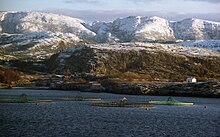Salmon farm

Salmon farming is a special form of aquaculture for the production of salmon under controlled conditions.
They include brood creation and rearing of the seedlings using the same methods as in the pond management of trout and other salmonids . The further rearing of the saplings for food fish requires the salmon to be kept in seawater or brackish water . To do this, the fish are kept in net enclosures , as can often be found in the Norwegian fjords and off the Chilean coast. Recently, salmon have also been raised in closed circulation systems .
The salmon are fed artificial feed, usually pellets based on pressed fish meal . As in other aquaculture areas, this results in a problem of environmental pollution from local eutrophication of the fjords and marine regions. In addition, fish meal is usually preserved with ethoxyquin , which can lead to its accumulation in the salmon. In contrast to meat, no limit values for ethoxyquin have yet been set for fish. However, the limit values of 50 µg / kg valid for meat are often exceeded many times over.
Another typical problem arises from factory farming , which is usually associated with the need for treatment with drugs against parasites such as salmon louse (Lepeophtheirus salmonis) and bacterial infections. The crab, just a few millimeters in size, ensured that the wholesale price for salmon increased by up to 50 percent in 2016. Lumpfish ( sea hare ) and baths in water enriched with hydrogen peroxide are also used against parasites . The previously intensive use of antibiotics against infections has become rarer since the introduction of machine-carried out vaccinations, but according to Greenpeace in 2018 it was 700 times the amount used in breeding cages in Norway in Chile.
In addition, the fauna can be falsified if salmon of a different origin that have escaped from net cages mix with the locally found salmon. In many Norwegian salmon rivers there is therefore an extended fishing season in which only farm fish may be caught in order to curb their reproduction. In Chile, which is located in the southern hemisphere, where salmon are not at all native, they lose their sense of direction and cannot find their way back into fresh water.
There are now numerous organic salmon farms in Europe. Scotland and Ireland are particularly active here. In Scotland, organic salmon are grown in the Outer Hebrides , the Orkneys and the Shetland Islands according to the guidelines of the British SOIL Association .
In order to alleviate the problems known from conventional breeding, there are clear guidelines for the rearing of organic salmon:
- regulated stocking density (10 kg / m³ water),
- the fishmeal used in the feed is said to come from catches caught for human consumption. Some fishmeal producers now use fish from sustainably certified fisheries for their organic feed, such as B. MSC ( Marine Stewardship Council ),
- the vegetarian ingredients in the feed come from ecologically certified agriculture,
- the use of antifouling agents on the enclosure nets is prohibited.
However, it cannot be assumed that the ecological problems of salmon farming have already been adequately addressed by these certifications. Extensive problems with viral infections are known for European, Canadian and South American salmon farms, which have led to a massive decline in wild salmon.
Web links
Individual evidence
- ↑ Simona Caminada: Swiss premiere: First salmon from Lostallo. In: srf.ch . September 21, 2018, accessed September 27, 2018 .
- ↑ Fish farming: Problems with antibiotics and pesticides. In: br.de . February 22, 2019, accessed March 1, 2019 .
- ↑ Rising wholesale prices due to salmon louse. January 15, 2017, accessed January 15, 2017 .
- ^ Mass exodus of farmed salmon in Chile , NZZ, August 15, 2018
- ↑ Wolfgang Luther: The hiking trails of the fish. In: Heini Hediger (Hrsg.): The streets of the animals (The science. Collection of individual representations from all areas of natural science, volume 125). Springer Wissenschaftsverlag , Wiesbaden 1967, ISBN 978-3-663-00331-1 , pp. 169-184 (here: p. 183).
- ↑ Science January 14, 2011: Vol. 331 No. 6014 pp. 214-217: Genomic Signatures Predict Migration and Spawning Failure in Wild Canadian Salmon

